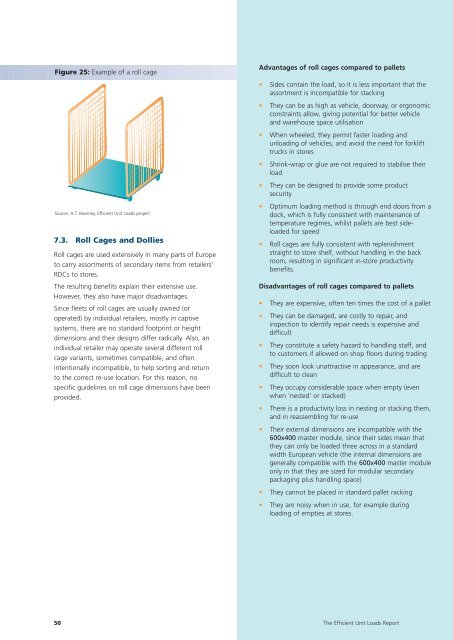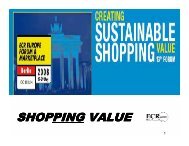You also want an ePaper? Increase the reach of your titles
YUMPU automatically turns print PDFs into web optimized ePapers that Google loves.
Figure 25: Example of a roll cage<br />
Source: A.T. Kearney, Efficient Unit Loads project<br />
7.3. Roll Cages and Dollies<br />
Roll cages are used extensively in many parts of Europe<br />
to carry assortments of secondary items from retailers’<br />
RDCs to stores.<br />
The resulting benefits explain their extensive use.<br />
However, they also have major disadvantages.<br />
Since fleets of roll cages are usually owned (or<br />
operated) by individual retailers, mostly in captive<br />
systems, there are no standard footprint or height<br />
dimensions and their designs differ radically. Also, an<br />
individual retailer may operate several different roll<br />
cage variants, sometimes compatible, and often<br />
intentionally incompatible, to help sorting and return<br />
to the correct re-use location. For this reason, no<br />
specific guidelines on roll cage dimensions have been<br />
provided.<br />
50<br />
Advantages of roll cages compared to pallets<br />
• Sides contain the load, so it is less important that the<br />
assortment is incompatible for stacking<br />
• They can be as high as vehicle, doorway, or ergonomic<br />
constraints allow, giving potential for better vehicle<br />
and warehouse space utilisation<br />
• When wheeled, they permit faster loading and<br />
unloading of vehicles, and avoid the need for forklift<br />
trucks in stores<br />
• Shrink-wrap or glue are not required to stabilise their<br />
load<br />
• They can be designed to provide some product<br />
security<br />
• Optimum loading method is through end doors from a<br />
dock, which is fully consistent with maintenance of<br />
temperature regimes, whilst pallets are best sideloaded<br />
for speed<br />
• Roll cages are fully consistent with replenishment<br />
straight to store shelf, without handling in the back<br />
room, resulting in significant in-store productivity<br />
benefits.<br />
Disadvantages of roll cages compared to pallets<br />
• They are expensive, often ten times the cost of a pallet<br />
• They can be damaged, are costly to repair, and<br />
inspection to identify repair needs is expensive and<br />
difficult<br />
• They constitute a safety hazard to handling staff, and<br />
to customers if allowed on shop floors during trading<br />
• They soon look unattractive in appearance, and are<br />
difficult to clean<br />
• They occupy considerable space when empty (even<br />
when ‘nested’ or stacked)<br />
• There is a productivity loss in nesting or stacking them,<br />
and in reassembling for re-use<br />
• Their external dimensions are incompatible with the<br />
600x400 master module, since their sides mean that<br />
they can only be loaded three across in a standard<br />
width European vehicle (the internal dimensions are<br />
generally compatible with the 600x400 master module<br />
only in that they are sized for modular secondary<br />
packaging plus handling space)<br />
• They cannot be placed in standard pallet racking<br />
• They are noisy when in use, for example during<br />
loading of empties at stores.<br />
The Efficient Unit Loads Report










